Speak directly to the analyst to clarify any post sales queries you may have.
The commercial satellite imaging market delivers critical geospatial intelligence for organizations, enhancing data-driven decision-making and operational efficiency in increasingly complex business environments. Accessible satellite imaging solutions are equipping leaders to adapt strategy, seize new opportunities, and mitigate risks more effectively.
Market Snapshot: Commercial Satellite Imaging Market Size and Growth
In 2024, the commercial satellite imaging market is valued at USD 4.20 billion and is projected to reach USD 4.75 billion by 2025. By 2032, the market is anticipated to achieve USD 11.09 billion. This expansion is driven by innovations in satellite sensor technology, the rapid increase in Earth observation missions, and the strengthening of public-private partnerships. Organizations are increasingly depending on high-resolution satellite imagery integrated with analytics to support rapid decision-making, operational agility, and sustained competitive advantage.
Scope & Segmentation
- Imaging Modalities: Hyperspectral imaging enables detailed environmental, agricultural, and defense monitoring. Optical imaging, with multispectral and panchromatic features, offers extensive geographic flexibility. Synthetic aperture radar (SAR) allows continuous monitoring essential for sectors that require persistent surveillance capability.
- Resolution Classes: High-resolution imaging supports precise asset tracking and infrastructure analysis. Medium-resolution solutions focus on timely trend detection. Low-resolution imaging is crucial for regional-scale agricultural assessment and climate monitoring.
- Orbit Classes: Geostationary satellites offer ongoing observation suited to emergency services and utilities. Low Earth orbit (LEO) satellites, including sun-synchronous versions, provide frequent data refresh for near real-time insight. Medium Earth orbit satellites deliver wide-area coverage, serving communications and hybrid monitoring efficiently.
- Application Areas: Satellite imaging advances agricultural management, infrastructure oversight, and resource assessment. It aids defense operations, compliance monitoring, urban planning, and supports energy and resource management initiatives, reinforcing sustainability and transparency goals.
- Geographic Coverage: North and South America, led by the United States, Brazil, and Canada, represent key users of imaging technologies. EMEA regions such as the UK, Germany, France, and Russia maintain robust activity, while Asia-Pacific markets—China, India, Japan, Australia, and Southeast Asia—tailor deployments according to regional strategic priorities.
- Key Companies: Providers including Maxar Technologies, Planet Labs, Airbus SE, BlackSky Global, Satellogic, SI Imaging Services, Capella Space, and ICEYE deliver scalable imaging services, addressing both commercial enterprise and governmental requirements.
Key Takeaways for Senior Decision-Makers
- Accelerated data cycles and refined accuracy are empowering organizations to adapt operational processes and make confident, timely decisions in dynamic market conditions.
- Geospatial analytics strengthen compliance and risk frameworks, enhancing transparency and helping enterprises meet evolving project and regulatory obligations on a global scale.
- The synergy of artificial intelligence with modular satellite systems improves the path from imagery acquisition to actionable intelligence, supporting distributed teams in proactive scenario management.
- Flexible commercial models, such as subscription and data-as-a-service, simplify access to mission-critical imagery and analytics and align with streamlined operational workflows.
- Understanding regional regulatory environments and forming strategic partnerships locally are essential for risk management and sustainable expansion internationally.
- Deploying advanced imaging and analytics reinforces due diligence and supports both entry into new markets and consolidation of existing operations.
Tariff Impact: Navigating U.S. Trade Regulations
Recent changes to U.S. tariffs have increased costs for satellite system components, putting additional pressure on project budgets and timelines. In response, companies are reorganizing their supply chains, moving toward nearshoring, and diversifying supplier relationships to minimize the risk of disruptions and maintain business continuity.
Methodology & Data Sources
The market analysis leverages quantitative modeling, ongoing trend tracking, comprehensive expert interviews, and technical assessment. Research draws upon primary and secondary sources, delivering insights precisely tailored for the decision-making needs of industry stakeholders.
Why This Report Matters
- Enables leaders to monitor technology and regulatory shifts impacting the commercial satellite imaging market and adjacent sectors.
- Equips organizations with clear recommendations for aligning operational strategy and sustaining regulatory compliance through industry shifts.
- Provides timely analytics critical to both immediate operational decisions and longer-term strategic planning needs.
Conclusion
As commercial satellite imaging evolves, organizations gain vital tools for managing risk, refining strategy, and achieving greater agility. This analysis empowers senior leaders with actionable intelligence essential for forward-looking, effective market leadership.
Additional Product Information:
- Purchase of this report includes 1 year online access with quarterly updates.
- This report can be updated on request. Please contact our Customer Experience team using the Ask a Question widget on our website.
Table of Contents
3. Executive Summary
4. Market Overview
7. Cumulative Impact of Artificial Intelligence 2025
Companies Mentioned
The companies profiled in this Commercial Satellite Imaging market report include:- Maxar Technologies Inc.
- Planet Labs PBC
- Airbus SE
- BlackSky Global LLC
- Satellogic Inc.
- SI Imaging Services Co., Ltd.
- Capella Space Corp.
- ICEYE Oyj
Table Information
| Report Attribute | Details |
|---|---|
| No. of Pages | 195 |
| Published | October 2025 |
| Forecast Period | 2025 - 2032 |
| Estimated Market Value ( USD | $ 4.75 Billion |
| Forecasted Market Value ( USD | $ 11.09 Billion |
| Compound Annual Growth Rate | 12.9% |
| Regions Covered | Global |
| No. of Companies Mentioned | 9 |









